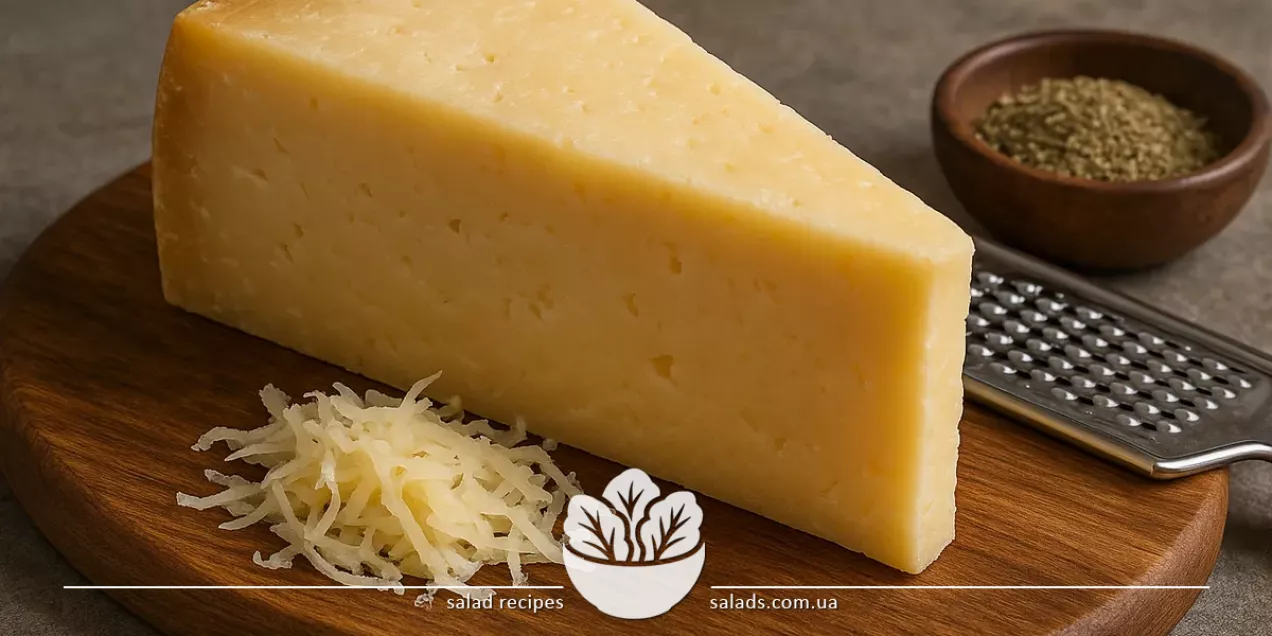
Hard Cheese

Hard cheese is made from cow's, sheep's, or goat's milk and matures over several weeks or months to develop a firm structure and intense flavor. It includes both classic varieties (such as Dutch, cheddar, Emmental) and local Ukrainian options. With low moisture and high protein content, it stores well, holds its shape when sliced, and is suitable for heat treatment. In cooking, hard cheese is used grated, sliced, or as a component of sauces and casseroles. You can explore other types of cheese in the relevant catalog section.
Salad Recipes with Hard Cheese
Characteristics and Nutritional Value
Hard cheese is a concentrated source of protein, calcium, phosphorus, and B vitamins. Due to its long maturation, it contains less moisture than soft or semi-hard cheeses, which improves shelf life, flavor intensity, and culinary stability. One hundred grams of hard cheese can contain up to 25-30 grams of protein, making it both tasty and nutritious for daily consumption. The fat content varies by type but generally ranges from 20-40%. Despite this, it is easily digested thanks to lactic acid bacteria that aid digestion. Hard cheese contains negligible amounts of lactose, making it suitable for people with intolerance. Its taste ranges from mild and delicate to distinctly sharp and aged with salt crystals. Its firm texture makes it easy to slice, grate, or melt. In salads, sandwiches, pizza, or casseroles, hard cheese often serves as the central ingredient, especially when combined with protein components like canned tuna. This pairing adds balance to the dish, enhancing both texture and flavor.
Hard Cheese in Sandwiches and Toasts
Hard cheese is one of the most convenient ingredients for making sandwiches – it slices easily, has a bold flavor, and doesn’t melt at room temperature. In daily meals, it’s used in slices or grated layers – in classic sandwiches, hot toasts, panini, or grilled options. Its compatibility with other ingredients – vegetables, meat, eggs, sauces, mustard – adds to its appeal. It’s also ideal for hot sandwiches and grilled dishes. When heated, the cheese softens into a deliciously stretchy texture without completely losing shape. This ensures a stable consistency in the finished dish. In school, office, or travel snacks, hard cheese is a popular choice thanks to its nutrition and ease of use. It’s best paired with quality bread, especially white wheat bread. This base has a neutral flavor, absorbs vegetable juices or sauces well, and doesn't overpower the cheese aroma. Combined with tomato, lettuce, or ham, it makes a balanced and nutritious sandwich – perfect for breakfast or on the go.
Salads, Side Dishes, and Vegetable Combinations
Hard cheese is widely used in vegetable salads – both traditional and modern fusion recipes. Grated cheese adds creaminess and saltiness, while slices or cubes provide textural variety. Thanks to its protein content, cheese makes dishes more filling and nutritious, even without meat or eggs. When combined with vegetables, hard cheese is often found in warm salads with roasted eggplant, zucchini, or bell pepper. These dishes are served as mains or sides to meat, poultry, or fish. In simple veggie mixes with lettuce, corn, tomatoes, or cucumbers, cheese adds body and character – especially when sprinkled on top before serving. A great example is salads with boiled or roasted root vegetables, especially carrots. Their sweet note is balanced by the cheese’s saltiness, and the crunchy or tender texture adds complexity to the dish. This pairing is common in vegetarian menus as well as traditional cuisines of the Mediterranean and Central Europe.
Pairing with Meat and Poultry
Hard cheese pairs wonderfully with meat ingredients, especially poultry, thanks to its ability to add creaminess, saltiness, and extra heartiness to dishes. It’s used as stuffing, topping, or sauce component in recipes with baked fillets, cutlets, roulades, and in casseroles or pies. In the dish, cheese forms a golden crust or melty layer that gives the final product a delicious look and balanced flavor. Pairings with chicken, turkey, or veal are particularly popular. Cheese is added to the stuffing, placed on top of fillets, or used as a filling along with spinach, herbs, or vegetables. This preparation suits both everyday lunches and festive meals. The combination of cheese with turkey is among the most diet-friendly options – the meat is lean and tender, while the cheese adds depth. It’s a classic choice for baked roulades, grilled meals, or warm salads that are both nutritious and well-balanced. As such, hard cheese remains relevant in healthy eating as well.
Hard Cheese in Mediterranean Cuisine
Hard cheeses are a key element of Mediterranean gastronomy. In Italy, Spain, France, or Greece, they are used not only as ingredients but also as stand-alone components – grated on top, baked, used as a sauce base, or served on cheese boards. The most famous examples include pasta with Parmesan, lasagna with a cheese crust, baked vegetables with cheese, or gratin-style classics. Combining hard cheese with tomatoes, olive oil, herbs, and spices creates a distinctive flavor profile that’s easy to recognize. In sauces, cheese acts as a thickener, flavor booster, and aromatic component. In appetizers – canapés, tartlets, mini sandwiches – grated cheese adds a finishing touch. A true classic is pairing hard cheese with black pitted olives. The saltiness, slight bitterness of the olives, and creamy, rich flavor of the cheese create a unique gastronomic balance. This duo is often found in dishes with bulgur, couscous, in pitas, or on cold appetizer platters.







